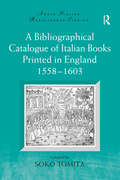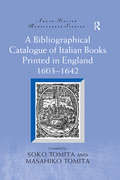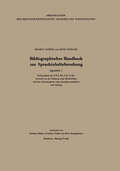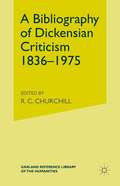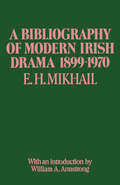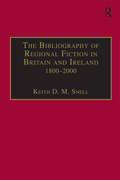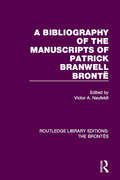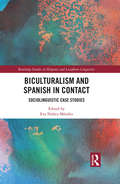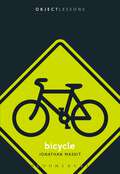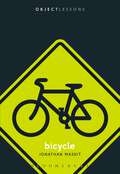- Table View
- List View
A Bibliographical Catalogue of Italian Books Printed in England 1558–1603 (Anglo-Italian Renaissance Studies)
by Soko TomitaThrough entries on 291 Italian books (451 editions) published in England during the reign of Queen Elizabeth I, covering the years 1558-1603, this catalogue represents a summary of current research and knowledge of diffusion of Italian culture on English literature in this period. It also provides a foundation for new work on Anglo-Italian relations in Elizabethan England. Mary Augusta Scott's 1916 Elizabethan Translations from the Italian forms the basis for the catalogue; Soko Tomita adds 59 new books and eliminates 23 of Scott's original entries. The information here is presented in a user-friendly and uncluttered manner, guided by Philip Gaskell's principles of bibliographical description; the volume includes bibliographical descriptions, tables, graphs, images, and two indices (general and title). In an attempt to restore each book to its original status, each entry is concerned not only with the physical book, but with the human elements guiding it through production: the relationship with the author, editor, translator, publisher, book-seller, and patron are all recounted as important players in the exploration of cultural significance. Renaissance Anglo-Italian relations were marked by both patriotism and xenophobia; this catalogue provides reliable and comprehensive information about books and publication as well as concrete evidence of what elements of Italian culture the English responded to and how Italian culture was acclimatized into Elizabethan England.
A Bibliographical Catalogue of Italian Books Printed in England 1558–1603 (Anglo-Italian Renaissance Studies)
by Soko TomitaThrough entries on 291 Italian books (451 editions) published in England during the reign of Queen Elizabeth I, covering the years 1558-1603, this catalogue represents a summary of current research and knowledge of diffusion of Italian culture on English literature in this period. It also provides a foundation for new work on Anglo-Italian relations in Elizabethan England. Mary Augusta Scott's 1916 Elizabethan Translations from the Italian forms the basis for the catalogue; Soko Tomita adds 59 new books and eliminates 23 of Scott's original entries. The information here is presented in a user-friendly and uncluttered manner, guided by Philip Gaskell's principles of bibliographical description; the volume includes bibliographical descriptions, tables, graphs, images, and two indices (general and title). In an attempt to restore each book to its original status, each entry is concerned not only with the physical book, but with the human elements guiding it through production: the relationship with the author, editor, translator, publisher, book-seller, and patron are all recounted as important players in the exploration of cultural significance. Renaissance Anglo-Italian relations were marked by both patriotism and xenophobia; this catalogue provides reliable and comprehensive information about books and publication as well as concrete evidence of what elements of Italian culture the English responded to and how Italian culture was acclimatized into Elizabethan England.
A Bibliographical Catalogue of Italian Books Printed in England 1603–1642 (Anglo-Italian Renaissance Studies)
by Soko Tomita Masahiko TomitaA sequel to Tomita’s A Bibliographical Catalogue of Italian Books Printed in England 1558-1603, this volume provides the data for the succeeding 40 years (during the reign of King James I and Charles I) and contributes to the study of Anglo-Italian relations in literature through entries on 187 Italian books (335 editions) printed in England. The Catalogue starts with the books published immediately after the death of Queen Elizabeth I on 24 March 1603, and ends in 1642 with the closing of English theatres. It also contains 45 Elizabethan books (75 editions), which did not feature in the previous volume. Formatted along the lines of Mary Augusta Scott's Elizabethan Translations from the Italian (1916), and adopting Philip Gaskell's scientific method of bibliographical description, this volume provides reliable and comprehensive information about books and their publication, viewed in a general perspective of Anglo-Italian transactions in Jacobean and part of Caroline England.
Bibliographisches Handbuch zur Sprachinhaltsforschung: Beiheft 1 (Arbeitsgemeinschaft für Forschung des Landes Nordrhein-Westfalen #16a / Beiheft 1)
by Helmut Gipper Hans Schwarz Hartmut Beckers Kristina Franke Horst SprengelmeyerNach Abschluß des zweiten Bandes (Lfg. 8-16, H-K) von Teil I des Handbuchs legen wir nun - ungefähr in der Mitte des Verfasseralphabets haltend - als vorläufiges Hilfsmittel für den Benutzer und als Probe auf Teil II des Werkes einen repräsentativen Querschnitt durch den geplanten Registerband vor. Der hierfür anstehende Stoff wird dabei auf zwei gesonderte Beihefte verteilt: Beiheft 1 (vorliegendes Heft) bringt neben dem für beide Hefte gültigen Verzeichnis der bei den Sprachangaben angewandten Abkürzungen eine vorwiegend nach dem Ge sichtspunkt der Ergiebigkeit für künftige Feldstudien getroffene Auswahl aus der Ord nung nach Sinnbezirken (B) und einen als zusätzliche Informationsquelle gedachten Auszug aus dem spezifizierenden Namenregister (C) sowie ferner als Anhang allfällige Ergänzungen zur Zeitschriftenbibliographie (S. CXV -CCIV), zum Rezensionsverzeich nis (S. CXIV) und zur Besetzung des Mitarbeiterstabes (S. CXIII). - In beiden Re gistern (B und C) ist innerhalb der einzelnen Ausschnitte der in Band 1-11 gebotene Stoff vollständig und - mit Ausnahme der von H. BECKERS bearbeiteten Gebiete - auch unter Ausnutzung der Verweise auf die zweite Alphabethälfte ausgewertet. Darüber hinaus sind in der Ordnung nach Sinnbezirken probeweise auch (gemäß Einl. , S. XCIII) bereits die inzwischen angefallenen Nachträge zu A-K eingearbeitet. Beiheft 2 (voraussichtlich im Herbst 1974 erscheinend) wird dann- allerdings unter Verzicht auf die Nachträge- das in sich selbst vollständige alphabetische Sach- und Problemregister (A) zu Band 1-11 und gegebenenfalls, sofern noch Raum verfügbar, eine Liste der im Handbuch von den Bearbeitern beiläufig gegebenen Erklärungen ein zelner Wörter oder Redewendungen (D) enthalten.
The Bibliography of Regional Fiction in Britain and Ireland, 1800–2000
by Keith D. SnellPioneering and interdisciplinary in nature, this bibliography constitutes a comprehensive list of regional fiction for every county of Ireland, Scotland, Wales and England over the past two centuries. In addition, other regions of a usually topographical or urban nature have been used, such as Birmingham and the Black Country; London; The Fens; the Brecklands; the Highlands; the Hebrides; or the Welsh border. Each entry lists the author, title, and date of first publication. The geographical coverage is encompassing and complete, from the Channel Islands to the Shetlands. An original introduction discusses such matters as definition, bibliographical method, popular readerships, trends in output, and the scholarly literature on regional fiction.
The Bibliography of Regional Fiction in Britain and Ireland, 1800–2000
by Keith D. SnellPioneering and interdisciplinary in nature, this bibliography constitutes a comprehensive list of regional fiction for every county of Ireland, Scotland, Wales and England over the past two centuries. In addition, other regions of a usually topographical or urban nature have been used, such as Birmingham and the Black Country; London; The Fens; the Brecklands; the Highlands; the Hebrides; or the Welsh border. Each entry lists the author, title, and date of first publication. The geographical coverage is encompassing and complete, from the Channel Islands to the Shetlands. An original introduction discusses such matters as definition, bibliographical method, popular readerships, trends in output, and the scholarly literature on regional fiction.
A Bibliography of the Manuscripts of Patrick Branwell Brontë (Routledge Library Editions: The Brontës)
by Victor A. NeufeldtThis bibliography, first published in 1993, attempts to provide a complete and accurate description of the manuscripts of Patrick Branwell Brontë, excluding his letters. Its aim is not only to correct previous errors and update and extend earlier lists, but also to reconstruct as far as possible dismembered and scattered manuscripts. This book will be of interest to students of English Literature.
A Bibliography of the Manuscripts of Patrick Branwell Brontë (Routledge Library Editions: The Brontës)
by Victor A. NeufeldtThis bibliography, first published in 1993, attempts to provide a complete and accurate description of the manuscripts of Patrick Branwell Brontë, excluding his letters. Its aim is not only to correct previous errors and update and extend earlier lists, but also to reconstruct as far as possible dismembered and scattered manuscripts. This book will be of interest to students of English Literature.
Bibliography on Land-locked States, Economic Development and International Law
by Martin Ira GlassnerNow fully revised and expanded, this is the only available bibliography on the subject of "land-lockedness" and its effects on economic development. Reflecting its expanded title, this new edition includes not only updated information on the plight of land-locked countries, but also their current levels of economic development and their role in international law, such as the International Law of the Sea, Kyoto Protocol on Greenhouse Gas Emissions, and international pipeline agreements. The volume lists thousands of primary and secondary source materials for research, including books, monographs, journals, governmental reports, NGO publications, and unpublished materials. The book is truly international in scope, with listings in 29 languages.
Bibliography on Land-locked States, Economic Development and International Law
by Martin Ira GlassnerNow fully revised and expanded, this is the only available bibliography on the subject of "land-lockedness" and its effects on economic development. Reflecting its expanded title, this new edition includes not only updated information on the plight of land-locked countries, but also their current levels of economic development and their role in international law, such as the International Law of the Sea, Kyoto Protocol on Greenhouse Gas Emissions, and international pipeline agreements. The volume lists thousands of primary and secondary source materials for research, including books, monographs, journals, governmental reports, NGO publications, and unpublished materials. The book is truly international in scope, with listings in 29 languages.
Bibliophobia: The End and the Beginning of the Book (Clarendon Lectures in English)
by Brian CummingsBibliophobia is a book about material books, how they are cared for, and how they are damaged, throughout the 5000-year history of writing from Sumeria to the smartphone. Its starting point is the contemporary idea of 'the death of the book' implied by the replacement of physical books by digital media, with accompanying twenty-first-century experiences of paranoia and literary apocalypse. It traces a twin fear of omniscience and oblivion back to the origins of writing in ancient Babylon and Egypt, then forwards to the age of Google. It uncovers bibliophobia from the first Chinese emperor to Nazi Germany, alongside parallel stories of bibliomania and bibliolatry in world religions and literatures. Books imply cognitive content embodied in physical form, in which the body cooperates with the brain. At its heart this relationship of body and mind, or letter and spirit, always retains a mystery. Religions are founded on holy books, which are also sites of transgression, so that writing is simultaneously sacred and profane. In secular societies these complex feelings are transferred to concepts of ideology and toleration. In the ambiguous future of the internet, digital immateriality threatens human equilibrium once again. Bibliophobia is a global history, covering six continents and seven religions, describing written examples from each of the last thirty centuries (and several earlier). It discusses topics such as the origins of different kinds of human script; the development of textual media such as scrolls, codices, printed books, and artificial intelligence; the collection and destruction of libraries; the use of books as holy relics, talismans, or shrines; and the place of literacy in the history of slavery, heresy, blasphemy, censorship, and persecution. It proposes a theory of writing, how it relates to speech, images, and information, or to concepts of mimesis, personhood, and politics. Originating as the Clarendon Lectures in the Faculty of English at the University of Oxford, the methods of Bibliophobia range across book history; comparative religion; philosophy from Plato to Hegel and Freud; and a range of global literature from ancient to contemporary. Richly illustrated with textual forms, material objects, and art works, its inspiration is the power that books always (and continue to) have in the emotional, spiritual, bodily, and imaginative lives of readers.
Bibliophobia: The End and the Beginning of the Book (Clarendon Lectures in English)
by Brian CummingsBibliophobia is a book about material books, how they are cared for, and how they are damaged, throughout the 5000-year history of writing from Sumeria to the smartphone. Its starting point is the contemporary idea of 'the death of the book' implied by the replacement of physical books by digital media, with accompanying twenty-first-century experiences of paranoia and literary apocalypse. It traces a twin fear of omniscience and oblivion back to the origins of writing in ancient Babylon and Egypt, then forwards to the age of Google. It uncovers bibliophobia from the first Chinese emperor to Nazi Germany, alongside parallel stories of bibliomania and bibliolatry in world religions and literatures. Books imply cognitive content embodied in physical form, in which the body cooperates with the brain. At its heart this relationship of body and mind, or letter and spirit, always retains a mystery. Religions are founded on holy books, which are also sites of transgression, so that writing is simultaneously sacred and profane. In secular societies these complex feelings are transferred to concepts of ideology and toleration. In the ambiguous future of the internet, digital immateriality threatens human equilibrium once again. Bibliophobia is a global history, covering six continents and seven religions, describing written examples from each of the last thirty centuries (and several earlier). It discusses topics such as the origins of different kinds of human script; the development of textual media such as scrolls, codices, printed books, and artificial intelligence; the collection and destruction of libraries; the use of books as holy relics, talismans, or shrines; and the place of literacy in the history of slavery, heresy, blasphemy, censorship, and persecution. It proposes a theory of writing, how it relates to speech, images, and information, or to concepts of mimesis, personhood, and politics. Originating as the Clarendon Lectures in the Faculty of English at the University of Oxford, the methods of Bibliophobia range across book history; comparative religion; philosophy from Plato to Hegel and Freud; and a range of global literature from ancient to contemporary. Richly illustrated with textual forms, material objects, and art works, its inspiration is the power that books always (and continue to) have in the emotional, spiritual, bodily, and imaginative lives of readers.
Bibliotherapy: Books to Guide You Through Every Chapter of Life
by null Molly mastersA beautiful, thoughtful guide to finding your perfect next read, no matter what life’s throwing at you, from the founder of Aphra a.k.a. ‘your inclusive AF feminist book club’ Through turbulent times, stories keep us afloat. Books, particularly, console and guide us, feed our souls, and open our eyes to worlds, possibilities and experiences we may never have considered before. Many of us have been self-medicating with books for years without identifying the practice as ‘bibliotherapy’. This carefully curated collection will help you to identify the right reads for the right time. Whether you are in the throes of first love or the depths of heartbreak, embarking on a new beginning or questioning which path to take, use this guide to lose yourself in literature and find yourself anew, and discover the books that will always matter to you. Includes celebrated classics, as well as overlooked modern masterpieces, with a focus on underrepresented voices. Recommended reads, include: You Made a Fool of Death with Your Beauty by Akwaeke Emezi Good Morning, Midnight by Jean Rhys A Little Life by Hanya Yanagihara Letter to my Daughter by Maya Angelou The Days of Abandonment by Elena Ferrante Be Not Afraid of Love by Mimi Zhu
Bicultural Literature and Film in French and English (Routledge Studies in Comparative Literature)
by Phil Powrie Peter I. BartaThis book focuses on literature and cinema in English or French by authors and directors not working in their native language. Artists with hybrid identities have become a defining phenomenon of contemporary reality following the increased mobility between civilisations during the postcolonial period and the waves of emigration to the West. Cinema and prose fiction remain the most popular sources of cultural consumption, not least owing to the adaptability of both to the new electronic media. This volume considers cultural products in English and French in which the explicitly multi-focal representation of authors' experiences of their native languages/cultures makes itself conspicuous. The essays explore work by the peripheral and those without a country, while problematising what might be meant by the widely used but not always well-defined term ‘bicultural’. The first section looks at films by such well-known filmmakers working in France as Bouchareb, Kechiche, Legzouli and Dridi, as well as the animated feature Persepolis. Here the focus is on the representation of human experience in spatial terms, exploring the appropriation of territory cohabited by ‘local’ people, newcomers and their children, haunted by the cultural memories of distant places. The second part is devoted to multicultural authors whose ‘native’ language was English, Russian, Polish, Hungarian or Spanish (Beckett, Herzen, Voyeikova, Triolet, Conrad, Hoffmann, Kristof, Dorfman), and their creative engagement with difference. A study of the emergence of multilingual writing in Montaigne and an autobiographical essay by Elleke Boehmer on growing up surrounded by English, Dutch, Afrikaans and Zulu frame the volume's chapters. The collection relishes the freedom provided by liberation from the confines of one language and culture and the delight in creative multilingualism. This book will be of significant interest to those studying the subject of biculturalism, as well as the fields of comparative literature and cinema.
Bicultural Literature and Film in French and English (Routledge Studies in Comparative Literature)
by Phil Powrie Peter I. BartaThis book focuses on literature and cinema in English or French by authors and directors not working in their native language. Artists with hybrid identities have become a defining phenomenon of contemporary reality following the increased mobility between civilisations during the postcolonial period and the waves of emigration to the West. Cinema and prose fiction remain the most popular sources of cultural consumption, not least owing to the adaptability of both to the new electronic media. This volume considers cultural products in English and French in which the explicitly multi-focal representation of authors' experiences of their native languages/cultures makes itself conspicuous. The essays explore work by the peripheral and those without a country, while problematising what might be meant by the widely used but not always well-defined term ‘bicultural’. The first section looks at films by such well-known filmmakers working in France as Bouchareb, Kechiche, Legzouli and Dridi, as well as the animated feature Persepolis. Here the focus is on the representation of human experience in spatial terms, exploring the appropriation of territory cohabited by ‘local’ people, newcomers and their children, haunted by the cultural memories of distant places. The second part is devoted to multicultural authors whose ‘native’ language was English, Russian, Polish, Hungarian or Spanish (Beckett, Herzen, Voyeikova, Triolet, Conrad, Hoffmann, Kristof, Dorfman), and their creative engagement with difference. A study of the emergence of multilingual writing in Montaigne and an autobiographical essay by Elleke Boehmer on growing up surrounded by English, Dutch, Afrikaans and Zulu frame the volume's chapters. The collection relishes the freedom provided by liberation from the confines of one language and culture and the delight in creative multilingualism. This book will be of significant interest to those studying the subject of biculturalism, as well as the fields of comparative literature and cinema.
Biculturalism and Spanish in Contact: Sociolinguistic Case Studies (Routledge Studies in Hispanic and Lusophone Linguistics)
by Eva Núñez MéndezBiculturalism and Spanish in Contact: Sociolinguistic Case Studies provides an original and modern analysis of the field of language change and variation with a specific focus on Spanish as a language in contact. This edited collection, focuses on diachronic variationist approaches to the Spanish language in contact with other languages from a historical sociolinguistics perspective. Topics covered include: language planning and policies, education, biculturalism, linguistic variation issues in the Spanish of the southwestern United States, and other socio-historical and anthropological aspects of the contact situation.
Biculturalism and Spanish in Contact: Sociolinguistic Case Studies (Routledge Studies in Hispanic and Lusophone Linguistics)
by Eva Núñez-Méndez Dale Koike Javier Muñoz-BasolsBiculturalism and Spanish in Contact: Sociolinguistic Case Studies provides an original and modern analysis of the field of language change and variation with a specific focus on Spanish as a language in contact. This edited collection, focuses on diachronic variationist approaches to the Spanish language in contact with other languages from a historical sociolinguistics perspective. Topics covered include: language planning and policies, education, biculturalism, linguistic variation issues in the Spanish of the southwestern United States, and other socio-historical and anthropological aspects of the contact situation.
Bicycle (Object Lessons)
by Dr Jonathan MaskitObject Lessons is a series of short, beautifully designed books about the hidden lives of ordinary things. These days the bicycle often appears as an interloper in a world constructed for cars. An almost miraculous 19th-century contraption, the bicycle promises to transform our lives and the world we live in, yet its time seems always yet-to-come or long-gone-by. Jonathan Maskit takes us on an interdisciplinary ride to see what makes the bicycle a magical machine that could yet make the world a safer, greener, and more just place.Object Lessons is published in partnership with an essay series in The Atlantic.
Bicycle (Object Lessons)
by Dr Jonathan MaskitObject Lessons is a series of short, beautifully designed books about the hidden lives of ordinary things. These days the bicycle often appears as an interloper in a world constructed for cars. An almost miraculous 19th-century contraption, the bicycle promises to transform our lives and the world we live in, yet its time seems always yet-to-come or long-gone-by. Jonathan Maskit takes us on an interdisciplinary ride to see what makes the bicycle a magical machine that could yet make the world a safer, greener, and more just place.Object Lessons is published in partnership with an essay series in The Atlantic.
